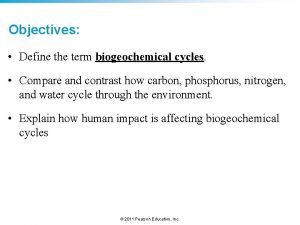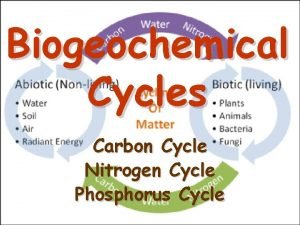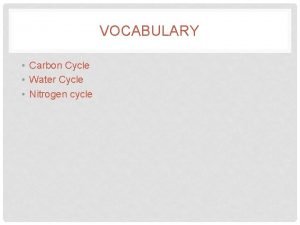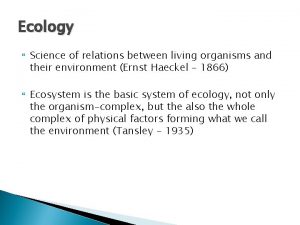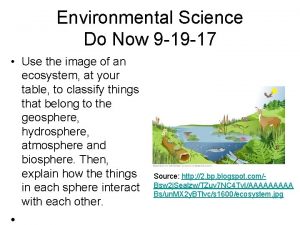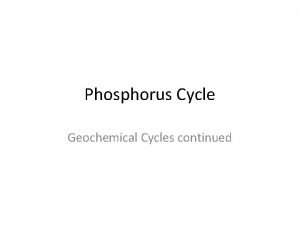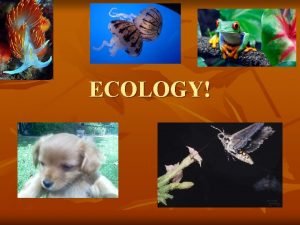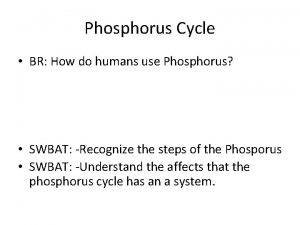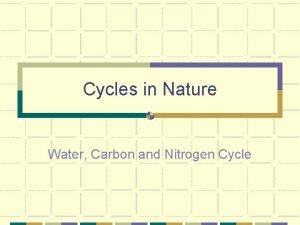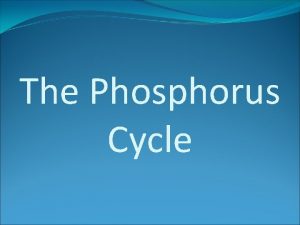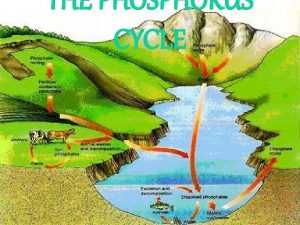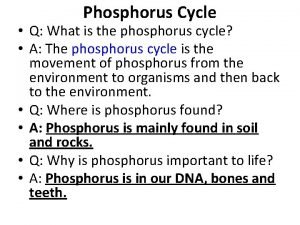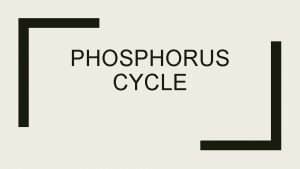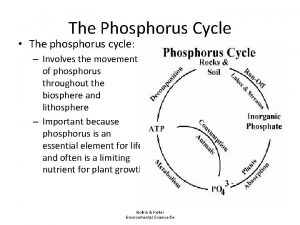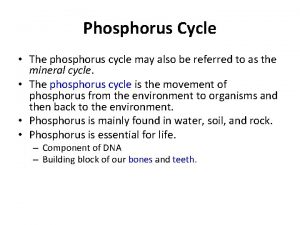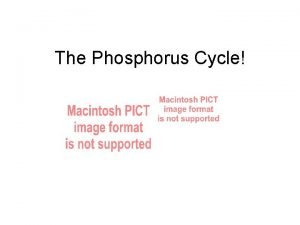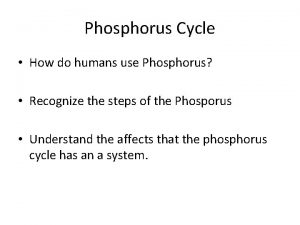THE PHOSPHORUS CYCLE WHAT IS THE PHOSPHORUS CYCLE











- Slides: 11

THE PHOSPHORUS CYCLE

WHAT IS THE PHOSPHORUS CYCLE? § The phosphorus cycle, is the circulation of phosphorous among the rocks, soils, water, and plants and animals of the earth. Human beings and all other organisms must have phosphorus to live. In nature, most phosphorus occurs in phosphate rock, which contains phosphate ions combined with calcium, magnesium, chlorine, and fluorine.

§ It cannot be found in air in the gaseous. This is because phosphorous is usually liquid at normal temperatures pressures. § This cycle is the slowest of the matter cycles. § Phosphorus is most commonly found in rock formations and ocean sediments as phosphate salts. Phosphates are also limiting factors for plant-growth in marine ecosystems, because they are not very water-soluble.

THE PROCESS OF THE PHOSPHOROUS CYCLE § The cycle basically starts out in the earth’s soil. The soil contains phosphate and when something grows out of the soil it should have phosphate as well. § When the plants grow they are consumed by herbivore and omnivore animals § The animal’s waste or the animal’s body when it dies becomes detritus. § Detritus is non-living organic material. When the detritus goes deep into the soil, detritivores in the soil decompose and become the soil’s phosphate and the cycle repeats.

§ Another example of the phosphorus cycle is when rocks are created. § The phosphate in the soil moves on and transfers its phosphate to the rocks underwater. When the uplifting of the rocks occurs it takes the phosphate along with it. After that the weathering of rocks occur and the rocks begin to break down into the soil and the phosphate in the rocks ends up in the soil again and the cycle repeats.

Uplifting of rocks Weathering of rock Phosphates in organic compounds Animals Plants Runoff Phosphates in solution Rock Precipitated (solid) phosphates Phosphates in soil (inorganic) Decomposition Detritus Detritivores in soil

All these examples of phosphates are inorganic (white boxes). However, the Phosphorus Cycle is also organic (yellow boxes). Not all phosphates in the runoff make it to the water; others sink into the soil. These inorganic phosphates are transformed into organic ones by plants, which are in turn eaten by animals. The dead animals, retain their internal phosphorus stores and detritivores (scavengers which feed on dead plants and animals or their waste) change the organic phosphates back to inorganic ones.

HOW DO HUMANS INTERFERE WITH THE PHOSPHORUS CYCLE? Ø Cutting and burning of tropical rain forests affects the phosphorus cycle. As the forest is cut and/or burned, nutrients originally stored in plants and rocks are quickly washed away by heavy rains, causing the land to become unproductive.

Agricultural runoff provides much of the phosphate found in waterways. Crops often cannot absorb all of the fertilizer in the soils, causing excess fertilizer runoff and increasing phosphate levels in rivers and other bodies of water. The phosphate in the water is eventually precipitated as sediments at the bottom of the body of water. In certain lakes and ponds this may be redissolved and recycled as a problem nutrient. ØAnimal wastes or manure may also be applied to the land as fertilizer. If misapplied on frozen ground during the winter, much of it may lost as run-off during the spring thaw. In certain area very large feed lots of animals, may result in excessive run-off of phosphate and nitrate into streams. CRAP

ØAnother human cause of artificial eutrophication is run-off from mines. Mining in areas where rock is rich in phosphorus minerals can create dust that is blown by wind into nearby water systems. § A major problem with the use of phosphorus in fertilizers is the process of artificial eutrophication. Eutrophication is a large increase in the primary productivity of a lake. Eutrophication can be harmful to the natural balance of a lake and result in massive death of fish and other animals as dissolved oxygen levels are depleted from the water.

Thank you for your attention we hope you enjoyed our presentation
 Quizlet
Quizlet Difference between phosphorus cycle and carbon cycle
Difference between phosphorus cycle and carbon cycle Phosphorus cycle labeled
Phosphorus cycle labeled Human impact on the phosphorus cycle
Human impact on the phosphorus cycle Phosphorus cycle
Phosphorus cycle Pearson
Pearson The phosphorus cycle
The phosphorus cycle Eutrophication comic strip
Eutrophication comic strip The phosphorus cycle
The phosphorus cycle Chapter 55 ecosystems and restoration ecology
Chapter 55 ecosystems and restoration ecology How do humans negatively affect the phosphorus cycle
How do humans negatively affect the phosphorus cycle Water cycle comic strip
Water cycle comic strip
